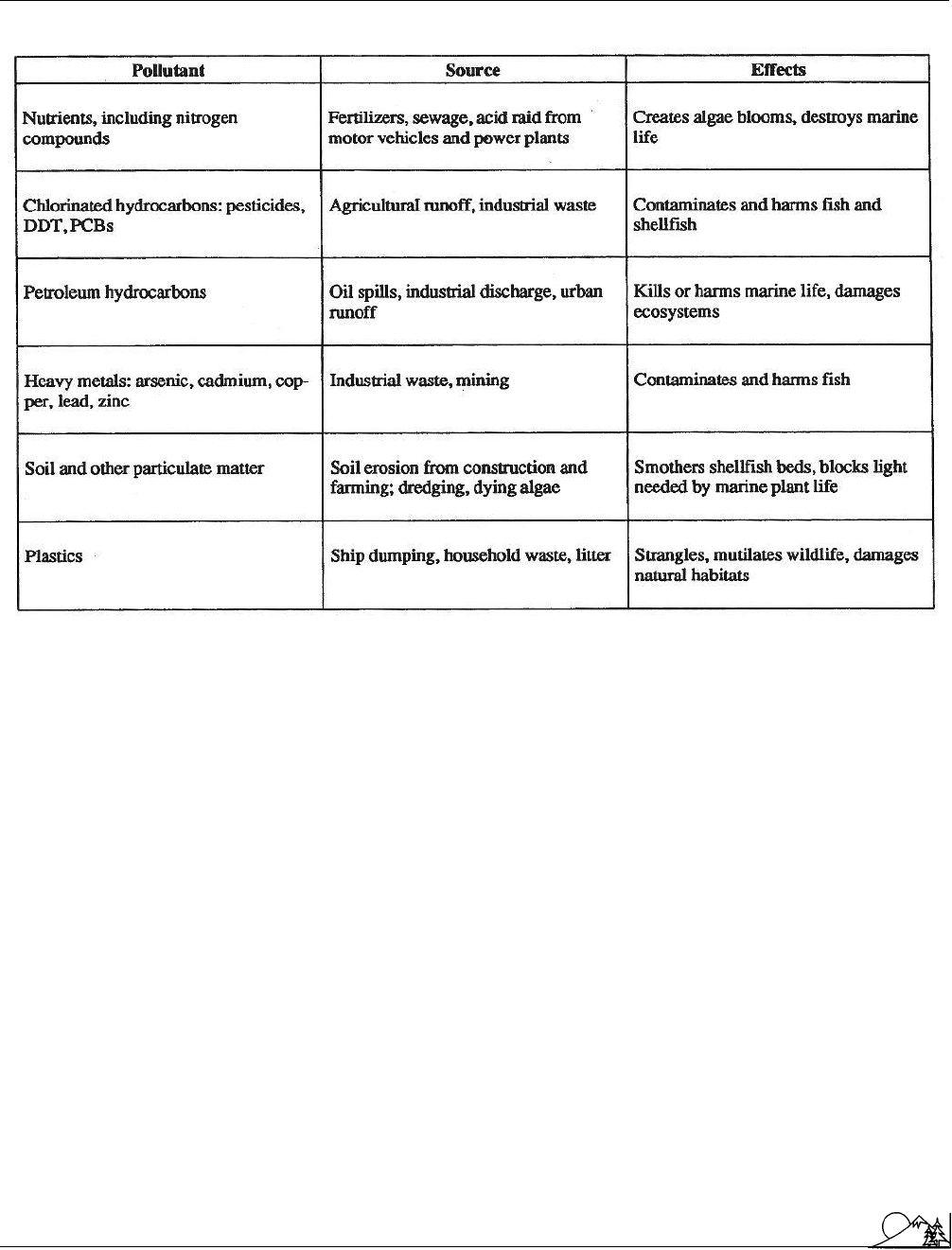Environmental Encyclopedia
Подождите немного. Документ загружается.


Environmental Encyclopedia 3
Water diversion projects
nating a recharging source for the
groundwater
table.
Eventually, structures put in place to prevent flood damage
may exacerbate the problem. Dams, levees, and other diver-
sional devices prevent water from heavy rainfalls from natu-
rally dispersing onto floodplains and wetlands.
Water diversion projects also impact the
atmosphere
.
Studies of large reservoirs created behind hydroelectric dams
have suggested that decaying vegetation, submerged by
flooding
, may give off quantities of greenhouse gases—such
as
methane
gas—equivalent to those from other sources of
electricity. Thus, hydroelectric facilities that flood large areas
of land may be significant contributors to global warming.
The
water quality
of many reservoirs also poses a health
hazard due to new forms of bacteria that grow in many of
the rivers that have been diverted by dams.
In addition to giving off
greenhouse gases
, bacteria
present in decaying vegetation can also change
mercury
,
present in rocks underlying a reservoir, into a water-soluble
form. The mercury accumulates in the bodies of fish and
poses a health hazard to both wildlife and humans who
depend on these fish as a food source. Methylmercury, the
most toxic form of the element, affects the immune system,
alters genetic and
enzyme
systems, and damages the nervous
system. Human exposure to methylmercury is almost entirely
by eating contaminated fish and wildlife.
A rather surprising global impact of water diversion
projects is that the weight of the world’s collective reservoirs
is speeding up the earth’s rate of rotation and is altering
the shape of earth’s magnetic field, according to NASA
geophysicist Dr. Benjamin Fong Chao.
Human impact
Estimates suggest that approximately 40–80 million
people have been physically displaced by dams worldwide.
Millions of people living downstream from dams, particu-
larly those who rely on natural floodplain function and fisher-
ies, have suffered serious damage to their livelihoods, and
the future productivity of their resources has been put at
risk. Many of the displaced are not recognized as such, and
therefore are not resettled or compensated. When compensa-
tion is provided, it is often inadequate. When the physically
displaced are acknowledged, many are not included in reset-
tlement programs. Moreover, those who are resettled seldom
have their livelihoods restored; resettlement programs usually
focus on physical relocation rather than the economic and
social needs of the displaced.
Indigenous and tribal peoples and vulnerable ethnic
minorities have suffered disproportionate levels of displace-
ment and negative impacts on not only their livelihood, but
also their cultural and spiritual existence. Large dams have
had significant adverse effects on cultural heritage through
the loss, submergence, and degradation of plant and animal
remains, burial sites, and archaeological monuments. The
1477
social, economic, and political status of minority groups
often restricts their capacity to assert their interests and
rights in land and
natural resources
, and restricts their
role in decision-making that affects them.
In addition, affected indigenous populations living
near reservoirs, as well as displaced people and downstream
communities, have often faced adverse health conditions
from environmental change and social disruption. Gender
gaps have widened in these communities, and women have
often borne a disproportionate share of the social costs while
reaping few of the benefits.
Policies and initiatives
Opposition to diversion projects and their impact on
the environment began to pick up momentum in the 1970s.
The
National Environmental Policy Act
of 1970 (NEPA)
required thorough study of the environmental impacts of
proposed water projects, and inspired greater public scrutiny
of the effects of major water projects on the environment.
In 1978, President Jimmy Carter announced a new policy
of cutting federal funding to new water projects, and devel-
oped a “hit list” of dams and irrigation projects.
The financial approach to water management evolved
as well. In 1982, the Reclamation Reform Act was signed
into law, changing the acreage requirements for irrigation
water subsidies in an effort to get large corporate farms to
pay a fair market price for their water use. The
Water
Resources
Development Act (WRDA)—legislation that is
reauthorized by Congress every two years to finance U.S.
Army Corps of Engineers’ water projects—contained
amendments in 1986 that required local interests to share
the construction costs of water resource projects built by the
Corps.
Environmentalists charge that the USBR and the
Army Corps have a history of developing water projects for
financial gain regardless of the cost to the environment. At
the heart of the debate is the fundamental difference in the
way natural water sources are viewed—as a fiscal commodity
or as a natural resource. As Marc Reisner, author of the
critically acclaimed Cadillac Desert, states: “In the East, to
‘waste’ water is to consume it needlessly or excessively. In
the West, to waste water is not to consume it—to let it flow
unimpeded and undiverted down rivers. ... To easterners,
‘conservation’ of water usually means protecting rivers from
development; in the West, it means building dams.” Striking
a balance between these two viewpoints to maintain both
our riparian ecosystem and our Western communities and
businesses, is the challenge facing American government,
environmentalists, and other stakeholders.
Because irrigation for farming is a major consumer
use of diverted water, improving growing techniques and
choosing water-friendly crops may be one solution to min-
imizing water need. The agricultural industry can also take

Environmental Encyclopedia 3
Water Environment Federation
steps to meet irrigation needs in a environmentally responsi-
ble manner by ensuring that adequate fish screens are in
place at diversion points and agreeing to lower water delivery
rates at crucial spawning times to maintain river flow for
migratory fish. Finally,
conservation
and restoration of ag-
ricultural wetlands through government plans such as the
Wetlands Reserve Program can help solve long-term flood-
ing problems on farms and restore the habitats of native
species.
The WRDA of 1999 enacted an Army Corps of Engi-
neers initiative known as “Challenge 21” focused on replac-
ing dams and other diversionary techniques for flood control
with non-structural solutions and environmental restoration
programs. Specifically, the initiative calls for less environ-
mentally-invasive programs of preventing flood damage, in-
cluding federally-funded voluntary buyouts of property on
flood plains and restoration of altered flood plain ecosystems.
International agreements and organizations have also
established standards for minimizing the negative impact of
human activities on biodiversity. Legal coalitions include the
World Charter for Nature, the Convention on Biological
Diversity, and Agenda 21; international organizations such
as the
World Bank
, the World Business Council on
Sus-
tainable Development
, and The World Conservation
Union (IUCN), have contributed to the development of
accepted standards. These standards involve conservation of
species and ecosystems, the recovery of degraded ecosystems,
the conservation of ecological functions or processes, secur-
ing of adequate information for decision-making, and the
adherence to high standards for environmental impact as-
sessments.
[Paula Anne Ford-Martin]
R
ESOURCES
B
OOKS
Committee on Missouri River Ecosystem Science; Water, Science, and
Technology Board; Division of Earth and Life Studies; National Research
Council. The Missouri River Ecosystem: Exploring the Prospects for Recovery.
Washington DC: National Academy Press; In press, 2002. Prepublication
copy available online at <http://books.nap.edu/books/0309083141/html/
R1.html>
MacDonnell, Lawrence. From Reclamation to Sustainability: Water, Agricul-
ture, and the Environment in the American West. Boulder: University Press
of Colorado, 1999.
McNully, Patrick. Silenced Rivers: The Ecology and Politics of Large Dams.
2nd edition. London: Zed Books, 2001.
Reisner, Marc. Cadillac Desert: The American West and Its Disappearing
Water. 2nd edition. New York: Penguin, 1987.
P
ERIODICALS
Bricker, Jennie, and David Filippi. “Endangered Species Act Enforcement
and Western Water Law.” Environmental Law 30, no.4 (Fall 2000): 735.
Robbins, Elaine. “Damning Dams.” emagazine.com (The Environmental
Magazine) X, no. 1 (January-February 1999): 16 [cited June 26, 2002].
<http://www.emagazine.com>.
1478
O
THER
LakeNet. Strategies and Solutions for Managing Water Diversion. May 15,
2002 [cited June 4, 2002]. <http://www.worldlakes.org/Strategies%20an-
d%20Solutions.htm>.
Stein, Jeff, et al. National Wildlife Federation & Taxpayers for Common
Sense. Troubled Waters: Congress, the Corps of Engineers, and Wasteful Water
Projects Washington, DC: NWF/Taxpayers for Common Sense, 2000.
<http://www.nwf.org/greeningcorps/report.html>.
O
RGANIZATIONS
American Rivers, 1025 Vermont Ave., N.W. Suite 720, Washington, DC
USA 20005 (202) 347-7550, Fax: (202) 347-9240, Email:
amrivers@amrivers.org, <http://www.amrivers.org>
International Rivers Network, 1847 Berkeley Way, Berkeley, CA USA
94703 (510) 848-1155, Fax: (510) 848-1008, Email: info@irn.org, <http://
www.irn.org>
U.S. Bureau of Reclamation, Freedom of Information Act (FOIA) Office,
PO Box 25007, D-7924, Denver, CO USA 80225-0007 (303) 445-2048,
Fax: (303) 445-6575, Toll Free: (800) 822-7646, Email: borfoia@usbr.gov,
<http://www.usbr.gov>
Water Environment Federation
Dedicated to “the preservation and enhancement of
water
quality
worldwide,” the Water Environment Federation
(WEF) is an international professional organization of water
quality experts. WEF is made up of 38,000 water profession-
als, including engineers, biologists, government officials,
treatment plant managers and operators, laboratory techni-
cians, equipment manufacturers and distributors, and edu-
cators.
WEF was founded in 1928 as the Federation of Sew-
age Works Associations and served as the publisher of the
Sewage Works Journal. The organization has also been known
as the
Water Pollution
Control Federation. Its scope has
broadened significantly since its inception, and WEF cur-
rently publishes a variety of materials relating to the water
industry. WEF also sponsors seminars, conferences, and
briefings; offers technical training and education; produces
informational videos for students; and provides input on
environmental legislation and regulations to government
bodies.
The publications issued by WEF cover a multitude of
topics and are geared toward a variety of readers. Technical
publications, including manuals developed by WEF’s Tech-
nical Practice Committee, brief water-quality professionals
on design, operation, and management innovations in the
field. Periodicals and newsletters address such issues as in-
dustry trends, research findings, water analysis topics, job
safety, regulatory and legislative developments, and job
openings in the profession.
WEF’s technical training and educational programs
are geared toward both professionals and students. Audio-
visual training courses and study guides are available on such
topics as
wastewater
treatment, waste stabilization ponds,

Environmental Encyclopedia 3
Water hyacinth
and wastewater facility management. The federation also
distributes health and safety videos developed by municipali-
ties. For students, WEF offers The Water Environment Cur-
riculum, a series of videos and guides outlining water quality
issues geared toward children in fifth through ninth grades.
The Water Environment Curriculum includes lessons on sur-
face water,
groundwater
, wastewater, and
water conser-
vation
. WEF also publishes guides on water quality issues
for the general public.
WEF’s major event is its annual conference, the largest
water quality and
pollution control
exposition in North
America. The conference features technical sessions, expert
speakers, and exhibits run by companies in the water quality
industry. The federation also holds specialty conferences on
such topics as toxicity, landfills, and surface water quality.
Two other noteworthy briefings are WEF’s Pacific Rim
Conference and the Washington Briefing. The Pacific Rim
Conference gathers representatives from Pacific Rim coun-
tries to discuss environmental problems in that area. The
Washington Briefing convenes government officials and
water quality experts to discuss current issues affecting the
industry.
In addition to its publications, educational tools, and
conferences, WEF sponsors an affiliate, the Water Environ-
ment Research Foundation, which works to develop and
implement water quality innovations. The research founda-
tion’s programs strive to find ways to enhance water quality,
develop broad-based approaches to water quality that en-
compass all aspects of the environment, use new technology,
and promote interaction among individuals involved in the
water quality profession.
WEF is also associated with Water Quality 2000, a
cooperative effort involving a variety of professional and
scientific organizations, industry representatives, environ-
mental groups, academic institutions, and government offi-
cials working on
water quality standards
and goals for
the United States for the twenty-first century.
[Kristin Palm]
R
ESOURCES
O
RGANIZATIONS
Water Environment Federation, 601 Wythe Street, Alexandria, VA USA
22314-1994 (703) 684-2452, Toll Free: (800) 666-0206, Email:
csc@wef.org, http://www.wef.org
Water hyacinth
The water hyacinth (Eichhornia crassipes) is an aquatic plant
commonly found in the southern United States, including
Florida, Texas, the Gulf Coast, and California. As an
intro-
duced species
, it has spread rapidly and is now viewed as
1479
Water hyacinth. (Photograph by Ray Coleman. Photo
Researchers Inc. Reproduced by permission.)
a noxious weed. Like other aquatic weeds, water hyacinth
can grow rapidly and clog waterways, damaging underwater
equipment and impairing navigational and recreational facil-
ities. It is also viewed as a weed in many tropical parts of
the world.
Water hyacinths can be either free-floating or rooted,
depending on the depth of the water. The plant height may
vary from a few inches to 3 ft (0.9 m). The leaves, growing
in rosettes, are glossy green and may be up to 8 in (20 cm)
long and 6 in (15 cm) wide. The showy, attractive flowers
may be blue, violet, or white and grow in spikes of several
flowers. The leaf blades are inflated with air sacs, which
enable the plants to float in water. The seeds are very long-
lived. Studies show that seeds that have been buried in mud
for many years remain viable under the right conditions,
leading to reinfestation of lakes long after chemical
treatment.
Weed harvesting methods to control water hyacinth
growth are expensive and not very effective. The weight and
volume of the harvested material usually adds greatly to the
costs of hauling and disposal. Attempts to use the harvested
material as
soil fertilizer
or enhancer have failed because
of the low mineral and nutritive content of the plant’s tissue.
Chemical methods to control water hyacinth usually require

Environmental Encyclopedia 3
Water pollution
careful and repeated applications. Commonly used herbi-
cides include Rodeo and Diquat.
In some situations, aquatic weeds serve beneficial pur-
poses. Aquatic plants can be integral components of
waste-
water
treatment, particularly in warm climates. Wastewater
is routed through lagoons or ponds with dense growths of
water hyacinth. In waters containing excess nutrients (
ni-
trates
and
phosphates
) and turbidity, water hyacinth plants
have been shown to improve
water quality
by taking up the
excess nutrients into the plant and by settling the suspended
solids which cause turbidity. They also add oxygen to the
water through
photosynthesis
. Oxygen is an essential re-
quirement for the
decomposition
of wastewater, and oxygen
deficiency is a common problem in waste treatment systems.
Water hyacinth has been used successfully in California and
Florida, and more states are exploring the possibility of using
water hyacinth in waste treatment systems.
[Usha Vedagiri]
R
ESOURCES
B
OOKS
Hammer, Donald A. Constructed Wetlands for Waste Treatment. Chelsea,
MI: Lewis Publishers, Inc., 1989.
Schmidt, James C. How to Identify and Control Water Weeds and Algae.
Milwaukee: Applied Biochemists, Inc., 1987.
Water pollution
Among the many environmental problems that offend and
concern us, perhaps none is as powerful and dramatic as
water
pollution
. Ugly, scummy water full of debris,
sludge
,
and dark foam is surely one of the strongest and most easily
recognized symbols of our misuse of the
environment
.
What is pollution? The verb “pollute” is derived from
the Latin polluere: to foul or corrupt. Our most common
meaning is to make something unfit or harmful to living
things, especially by the addition of waste matter or sewage.
A broader definition might include any physical, biological,
or chemical change in
water quality
that adversely affects
living organisms or makes water unsuitable for desired uses.
Paradoxically, however, a change that adversely affects
one organism may be advantageous to another. Nutrients
that stimulate oxygen consumption by bacteria and other
decomposers
in a river or lake, for instance, may be lethal
to fish but will stimulate a flourishing community of decom-
posers. Whether the quality of the water has suffered de-
pends on your perspective. There are natural sources of water
contamination, such as poison springs, oil seeps, and
sedi-
mentation
from
erosion
, but most discussions of water
pollution focus on human-caused changes that affect water
quality or usability.
1480
The most serious water pollutants in terms of human
health worldwide are pathogenic organisms. Altogether, at
least 25 million deaths each year are blamed on these water-
related diseases, including nearly two-thirds of the mortali-
ties of children under five years old. The main source of
these pathogens is from untreated or improperly treated
human wastes. In the more developed countries,
sewage
treatment
plants and other
pollution control
techniques
have reduced or eliminated most of the worst sources of
pathogens in inland surface waters. The United Nations
estimates that 90% of the people in high-income countries
have adequate sewage disposal, and 95% have clean drinking
water.
For poor people, the situation is quite different. The
United Nations estimates that three-quarters of the popula-
tion in less-developed countries have inadequate
sanitation
,
and that less than half have access to clean drinking water.
Conditions are generally worse in remote, rural areas where
sewage treatment is usually primitive or nonexistent, and
purified water is either unavailable or too expensive to obtain.
In the 33 poorest countries, 60% of the urban population
have access to clean drinking water but only 20% of rural
people do.
This lack of pollution control is reflected in surface and
groundwater
quality in countries that lack the resources or
political will to enforce pollution control. In Poland, for
example, 95% of all surface water is unfit to drink. The
Vistula River, which winds through the country’s most heav-
ily industrialized region, is so badly polluted that more than
half the river is utterly devoid of life and unsuited even for
industrial use. In Russia, the lower Volga River is reported
to be on the brink of disaster due to the 300 million tons
(272.2 million metric tons) of
solid waste
and 20 trillion
L (5 trillion gal) of liquid
effluent
dumped into it annually.
The less-developed countries of South America, Af-
rica, and Asia have even worse water quality than do the
poorer countries of Europe. Sewage treatment is usually
either totally lacking or woefully inadequate. Low technolog-
ical capabilities and little money for pollution control are
made even worse by burgeoning populations, rapid urbaniza-
tion, and the shift of heavy industry from developed countries
where pollution laws are strict to
less developed countries
where regulations are more lenient.
In Malaysia, 42 of 50 major rivers are reported to be
“ecological disasters.” Residues from palm oil and
rubber
manufacturing, along with heavy erosion from
logging
of
tropical rain forests, have destroyed all higher forms of life
in most of these rivers. In the Philippines, domestic sewage
makes up 60–70% of the total volume of Manila’s Pasig
River. Thousands of people use the river not only for bathing
and washing clothes, but also as their source of drinking
and cooking water. China treats only 2% of its sewage. Of

Environmental Encyclopedia 3
Water pollution
78 monitored rivers in China, 54 are reported to be seriously
polluted. Of 44 major cities in China, 41 use “contaminated”
water supplies, and few do more than rudimentary treatment
before it is delivered to the public.
Pollution control standards and regulations usually dis-
tinguish between point and nonpoint pollution sources. Fac-
tories,
power plants
, sewage treatment plants, underground
coal
mines, and oil
wells
are classified as point sources
because they
discharge
pollution from specific locations,
such as drain pipes, ditches, or sewer outfalls. These sources
are discrete and identifiable, so they are relatively easy to
monitor and regulate. It is generally possible to divert effluent
from the waste streams of these sources and treat it before
it enters the environment.
In contrast, nonpoint sources of water pollution are
scattered or diffused, having no specific location where they
discharge into a particular body of water. Nonpoint sources
include
runoff
from farm fields,
golf courses
, lawns and
gardens, construction sites, logging areas, roads, streets, and
parking lots. Multiple origins and scattered locations make
this pollution more difficult to monitor, regulate, and treat
than point sources.
Desert
soils often contain high salt concentrations
that can be mobilized by
irrigation
and concentrated by
evaporation, reaching levels that are toxic for plants and
animals. Salt levels in the San Joaquin River in central Cali-
fornia rose about 50% between 1930 to 1970 as a result of
agricultural runoff.
Salinity
levels in the
Colorado River
and surrounding farm fields have become so high in recent
years that millions of acres of valuable croplands have had
to be abandoned. The United States is building a huge
desalination plant at Yuma, Arizona, to reduce salinity in
the river. In northern states, millions of tons of sodium
chloride and calcium chloride are used to melt road ice in
the winter. The corrosive damage to highways and automo-
biles and the toxic effects on vegetation are enormous.
Leach-
ing
of road salts into surface waters has a similarly devasta-
ting effect on aquatic ecosystems.
Acids are released by mining and as by-products of
industrial processes, such as leather tanning, metal smelting
and plating,
petroleum
distillation, and organic chemical
synthesis. Coal mining is an especially important source of
acid
water pollution. Sulfides in coal are solubilized to make
sulfuric acid. Thousands of miles of streams in the United
States have been poisoned by acids and metals, some so
severely that they are essentially lifeless.
Thousands of different natural and synthetic organic
chemicals
are used in the chemical industry to make pesti-
cides,
plastics
, pharmaceuticals, pigments, and other prod-
ucts that we use in everyday life. Many of these chemicals
are highly toxic. Exposure to very low concentrations can
cause
birth defects
, genetic disorders, and
cancer
. Some
1481
synthetic chemicals are resistant to degradation, allowing
them to persist in the environment for many years. Contami-
nation of surface waters and groundwater by these chemicals
is a serious threat to human health.
Hundreds of millions of tons of hazardous organic
wastes are thought to be stored in dumps, landfills, lagoons,
and underground tanks in the United States. Many, perhaps
most, of these sites are leaking toxic chemicals into surface
waters or groundwater or both. The
Environmental Protec-
tion Agency
(EPA) estimates that about 26,000
hazardous
waste
sites will require cleanup because they pose an immi-
nent threat to public health, mostly through water pollution.
Although the oceans are vast, unmistakable signs of
human abuse can be seen even in the most remote places.
Garbage
and human wastes from coastal cities are dumped
into the ocean.
Silt
, fertilizers, and pesticides from farm
fields smothered coral reefs, coastal spawning beds, and over-
fertilize estuaries. Every year millions of tons of plastic litter
and discarded fishing nets entangle aquatic organisms,
dooming them to a slow death. Generally coastal areas,
where the highest concentrations of sea life are found and
human activities take place, are most critically affected.
The amount of oxygen dissolved in water is a good
indicator of water quality and of the kinds of life it will
support. Water with an oxygen content above 8
parts per
million
(ppm) will support game fish and other desirable
forms of aquatic life. Water with less than 2 ppm oxygen will
support only worms, bacteria,
fungi
, and other decomposers.
Oxygen is added to water by diffusion from the air, especially
when turbulence and mixing rates are high, and by
photo-
synthesis
of green plants, algae, and cyanobacteria. Oxygen
is removed from water by
respiration
and chemical pro-
cesses that consume oxygen.
In spite of the multitude of bad news about water
quality, some encouraging pollution control stories are
emerging. One of the most outstanding examples is the
Thames River in London. Since the beginning of the Indus-
trial Revolution, the Thames had been little more than an
open sewer, full of vile and toxic waste products from domes-
tic and industrial sewers. In the l950s, however, England
undertook a massive cleanup of the Thames. More than $250
million in public funds plus millions more from industry were
spent to curb pollution. By the early l980s, the river was
showing remarkable signs of rejuvenation. Oxygen levels
had rebounded and some 95
species
of fish had returned,
including the pollution-sensitive
salmon
, which had not
been seen in London for 300 years. With a little effort, care,
and concern for the environment, similar improvements can
develop elsewhere.
[William P. Cunningham]

Environmental Encyclopedia 3
Water quality
Major pollutants of coastal waters around the United States. (Beacon Press. Reproduced by permission.)
R
ESOURCES
B
OOKS
Mayberck, M. Global Freshwater Quality: A First Assessment. Oxford, UK:
Blackwell Reference, 1990.
O
THER
Protecting Our Future Today. Washington, DC: Environmental Protection
Agency, 1991.
Water quality
Water quality encompasses a wide range of water characteris-
tics, including biological, chemical, and physical descriptions
of water clarity or contamination. Water quality assessment
is typically based on the examination of certain attributes,
conditions or properties of a lake, river, bay,
aquifer
,or
other water body. The most important of these attributes
are pollutants that demand oxygen or cause disease, nutrients
that stimulate excessive plant growth, synthetic organic and
inorganic
chemicals
, mineral substances, sediments, radio-
active substances, and temperature. Since the 1950s, routine
tests for water quality have evaluated temperature, turbidity,
1482
color, odor, total solids after evaporation, hardness (
pH
), and
concentrations of
carbon dioxide
, iron,
nitrogen
, chloride,
active
chlorine
,
microorganisms
,
coliform bacteria
, and
amorphous matter. In recent years increasing contamination
and growing public concern over water quality have led to
the addition of a number of additional parameters, including
algal growth,
chemical oxygen demand
, and the presence
of
hydrocarbons
, metals, and other toxic substances.
Water quality is evaluated through a set of samples
taken from a cross-section of a body of water. Because quality
conditions change continually, each set of samples is under-
stood to represent conditions at the time of sampling. Long-
term water quality monitoring requires periodic data collec-
tion at regular sampling stations. In order to ensure that
quality measurements are consistent at different times and
locations, standards are legally set for various water uses and
contaminant levels. There are two general types of standards
for measuring water quality. “Water quality based standards”
are set to ensure that a water body is clean enough for its
expected uses, e.g., fishing, swimming, industrial use, or
drinking. “Technology based standards” are set for
waste-

Environmental Encyclopedia 3
Water quality
water
entering a water body so that overall water conditions
remain acceptable. These standards have been developed
worldwide. In the United States, the
Environmental Pro-
tection Agency
(EPA) is responsible for developing
water
quality standards
and criteria for surface, ground, and
marine waters.
Water quality standards, ambient conditions of a water
body that meet expected uses, are based upon water quality
criteria. These criteria designate acceptable levels of specific
pollutants, clarity, or oxygen content. Usually acceptable
levels of these criteria are measured in
parts per million
(ppm) of each contaminant or
nutrient
. These measure-
ments allow scientists to assess whether or not a body of
water meets the prescribed water quality standards. If stan-
dards are not met, then local governing bodies or industries
must develop and implement cleanup strategies that target
specific criteria. In the United States and many other coun-
tries, national water quality criteria have been developed for
most conventional, toxic, and non-conventional pollutants.
Conventional pollutants include suspended solids,
biochem-
ical oxygen demand
(BOD), pH (acidity or alkalinity),
fecal coliform bacteria, oil, and grease. Toxic priority pollut-
ants include metals and organic chemicals. Non-conven-
tional pollutants are any other contaminants that harm hu-
mans or marine resources and require regulation.
Drinking water must meet especially high standards to
be safe for human consumption, and its quality is strictly mon-
itored in the United States and most heavily populated regions
of the world. Most governments have a legal responsibility to
maintain acceptable drinking water quality. Until 1974, ef-
forts to maintain acceptable levels of drinking water quality
in the United States were limited to preventing the spread of
contagious diseases. The
Safe Drinking Water Act
of 1974
expanded the government’s regulatory role to cover all sub-
stances that may adversely affect human health or a water bo-
dy’s odor or appearance. This act established national regula-
tions for acceptable levels of various contaminants.
Both point and nonpoint sources of
pollution
affect
water quality. Point sources are discrete locations that
dis-
charge
pollutants, mainly industrial outflow pipes or
sew-
age treatment
plants. Nonpoint sources are more diffuse,
and include
storm runoff
and
runoff
from farming,
log-
ging
, construction, and other
land use
activities.
In the United States, over 50% of the population relies
on underground sources for drinking water. Because
groundwater
receives an enormous range of agricultural,
industrial, and urban pollutants, groundwater quality is an
issue of growing concern. Preventing
groundwater pollu-
tion
is especially important because remedial action in an
aquifer is expensive and technologically difficult. Major
sources of groundwater pollution include nitrate contamina-
tion from septic systems, organic pollutants from leaking
1483
fuel tanks and other storage containers, and an array of
contaminants leached from landfills.
In rivers, the most extensive causes of water quality
impairment are usually
siltation
, nutrient concentration (ni-
trogen and
phosphorus
), fecal coliform bacteria, and low
dissolved oxygen
levels caused by high organic content
(sewage, grass clippings, pasture and
feedlot runoff
, etc.).
Agricultural runoff including pesticides, fertilizers, and sedi-
ments is the largest source of river pollution, followed by
municipal sewage discharge. Estuaries, rich ecosystems of
mixed salt and fresh water where rivers enter a sea or ocean,
often have serious water quality problems. Estuarine contam-
inants are usually the same as those in rivers—high organic
content and low oxygen, disease-causing pathogens, organic
chemicals, and municipal sewage discharge.
In most lakes, water quality is affected primarily by
nitrogen and phosphorus
loading
, siltation and low dis-
solved oxygen. Like rivers, lakes suffer from agricultural
runoff,
habitat
modification, storm runoff, and municipal
sewage
effluent
. Lakes especially suffer from eutrophication
(the excessive growth of aquatic algae and other plants)
caused by high levels of nutrients. This burst of growth, also
called an
algal bloom
, feeds on concentrated nutrients.
Thick mats of algae and other aquatic plants clog water
systems, increase turbidity, and suffocate aquatic animals so
that an entire
ecosystem
is disrupted. Of the lakes assessed
by the U.S. Environmental Protection Agency’s 1988 Na-
tional Water Quality Inventory, one-third were affected by
eutrophication. In some lakes, especially the
Great Lakes
,
the presence of persistent toxic substances is an additional
concern. Most of these
toxins
originate in the industrial
regions that surround these lakes or in the heavy shipping
traffic between lakes.
Water quality degradation affects the
stability
of
aquatic ecosystems as well as human health. Much is still
unknown about the effects of specific pollutants on
ecosys-
tem health
. However, fish and other aquatic organisms
exposed to elevated levels of pollutants may have lowered
reproduction and growth rates, diseases, and, in severe cases,
high death rates. See also Cultural eutrophication
[Marci L. Bortman Ph.D.]
R
ESOURCES
B
OOKS
Becker, C. D., ed. Water Quality in North American River Systems. Colum-
bus, OH: Battelle Press, 1992.
Cotruvo, J. A., and E. Bellack. “Maintaining Drinking Water Quality.” In
Perspectives on Water, edited by D. H. Speidel, et al. New York: Oxford
University Press, 1988.
Eckenfelder Jr., W. W. Principles of Water Quality Management. Boston:
CBI Publishing, 1980.

Environmental Encyclopedia 3
Water quality standards
O
THER
U.S. Environmental Protection Agency. National Water Quality Inventory
1988 Report to Congress. Washington, DC: U.S. Government Printing
Office, 1990.
U.S. Environmental Protection Agency. The Quality of Our Nation’s Water.
Washington, DC: U.S. Government Printing Office, 1990.
Water quality standards
The development of
water quality
standards is a process
first mandated by the Water Quality Act of 1965 and contin-
ued by requirements in the Federal
Water Pollution
Control
Act of 1972 (PL 92-500), with amendments in 1977, 1982,
and 1987 (collectively referred to as the
Clean Water Act
).
The process is used to establish standards for stream water
quality by taking into account the use and value of a stream
for public water supplies, propagation of fish and
wildlife
,
recreational purposes, as well as agricultural, industrial, and
other legitimate uses. Water quality standards are enforce-
able by law and are applicable to all navigable waters. The
goals of water quality standards are to protect public health
and the
environment
, and to maintain a standard of water
quality consistent with its designated uses. Water quality
standards provide the “teeth” for water quality legislation and
also the yardstick by which performance may be evaluated.
To establish water quality standards for a water body,
officials (1) determine the designated beneficial water use;
(2) adopt suitable water quality criteria to protect and main-
tain that use; and (3) develop a plan for implementing and
enforcing the water quality criteria. Both uses and criteria
constitute water quality standards, and water quality is evalu-
ated based on how well the designated uses are supported.
Appropriate water use is designated by analyzing the
existing use of the water as well as the potential to attain
other uses based on an assessment of the physical, chemical,
biological, and hydrological characteristics of the water and
the economic cost and impact of achieving particular uses.
The Clean Water Act requires that, whenever possible, water
quality standards should ensure the protection and propaga-
tion of fish, shellfish, and wildlife and should provide for
recreation
in and on the stream. States have primary respon-
sibility for designating stream segment uses, so stream uses
may vary from state to state. However, stream use as desig-
nated by one state must not result in the violation of another
state’s use of the same stream.
Water quality criteria are most often expressed as nu-
meric constituent concentrations or levels, but may be narra-
tive statements if numeric values are not available or known.
Each criterion is based on scientific information available
concerning the effect of the pollutant on human health,
aquatic life, and aesthetics.
Before the passage of the Clean Water Act, water
pollution control
efforts were considered successful if they
1484
achieved water quality standards. However, under the act,
the accepted measurements of successful water
pollution
control is whether the
effluent
from point sources, specifi-
cally Publicly Owned Treatment Works (POTWs), meets
technology-based effluent standards. These standards are
based on what can be done with available technology rather
than what is required to achieve water quality standards.
Water quality standards were retained, however, as
part of the overall strategy to control water pollution. Rather
than using water quality standards as the highest goal for
determining water quality, the state and federal authorities
consider water quality control standards to be the lowest
acceptable level of water quality. In addition, point sources
may be subjected to more stringent requirements than the
use of
Best Available Control Technology
(BAT) if neces-
sary to meet water quality standards. For example, in stream
segments that do not meet water quality standards, states
can establish a “total maximum daily load” of pollutants that
will achieve water quality standards and assign a permissible
share to individual dischargers. State water quality programs
must also include provisions to prevent degradation of ex-
isting water quality when necessary to maintain existing uses
and certain high quality waters.
The attainment of water quality standards is also af-
fected by control of pollution from nonpoint sources, such as
agricultural practices that result in the addition of sediments,
nutrients, pesticides, and other contaminants to water bod-
ies. The 1987 amendments to the Clean Water Act required
states to identify water not meeting its standards due to
nonpoint source
pollution, identify general and specific
nonpoint sources causing the problems, and develop man-
agement plans for the control of the these sources.
In 1988, state governments compiled a water quality
report for the
Environmental Protection Agency
(EPA).
The report indicated that of 519,412 river miles (835,734
km) assessed (out of a total of 1.8 million mi [2.9 million
km] in the United States) 10% did not support their desig-
nated uses, 20% partially supported their uses, and 70%
fully supported their uses. For lakes, of 16,313,962 acres
(6,525,585 ha) assessed (out of a total of 39,400,000 acres
[15,760,000 ha] in the United States), 10% did not support
their designated uses, 17% partially supported their uses,
and 74% fully supported their uses. See also Agricultural
pollution; Agricultural runoff; Criteria pollutant; Marine
pollution; Thermal pollution
[Judith Sims]
R
ESOURCES
B
OOKS
Abron, L. A., and R. A. Corbitt. “Air and Water Quality Standards.” In
Standard Handbook of Environmental Engineering, edited by R. A. Corbitt.
New York: McGraw-Hill, 1990.

Environmental Encyclopedia 3
Water reclamation
O
THER
The Universities Council on Water Resources. “The Clean Water Act.”
Water Resources Update 84. Carbondale, IL: Southern Illinois University,
1991.
Water reclamation
Theterm “water reclamation” canbe defined in differentways.
In the early and mid-1900s, water
reclamation
referred pri-
marily to supplying potable water to
arid
areas where water
was not readily available, through the development of water
projects such as
dams
and canals. Water reclamation can also
mean collecting used water (i.e.,
wastewater
) and treating
it for
reuse
for
irrigation
and other purposes.
The federal agency primarily responsible for water rec-
lamation projects that provided a source of water to arid lands
isthe
BureauofReclamation
,in the Departmentof the Inte-
rior. Formed in 1902 as the Reclamation Service and later
renamed the Bureau of Reclamation in 1923, the agency’s
mission was “the construction and maintenance of irrigation
works for the storage, diversion, and development of water
for the reclamation of arid and semi-arid lands.” This federal
agency built dams, reservoirs, and other water development
projects in the 17 western states of the United States. The
mission of the Bureau of Reclamation in the early 1900s was
to serve the irrigation needs of farms of 160 acres (65 ha) or
less. By the 1930s thebureau’s constituency expanded to larger
farms, towns, and cities. The
Army Corps of Engineers
and
the Department of Agriculture
Soil Conservation Service
(now called the
Natural Resources Conservation
Service)
are also responsible for providing irrigation water in addition
to providing flood control,
drainage
, and navigation.
During the early 1900s, water reclamation projects were
a means of providing an opportunity for people to settle in
the western United States. The projects provided inexpensive,
government-subsidized water used for
transportation
,
farming, industry, and by municipalities for drinking water
and electricity. During the Depression era of the 1930s, the
Bureau of Reclamation and the Public Works Administration
worked together on water projects, which became an impor-
tant part of the nation’s economic recovery program.
In 1959, a Senate Select Committee on National
Water
Resources
was formed to determine whether more water
projects were necessary. After two years of investigations, the
committee highlighted three main concerns: possible water
shortages in the future, decreasing
water quality
, and possi-
ble
flooding
. Some of the recommendations made by the
committee to address these concerns included increased regu-
lation of stream flows by reservoirs, improved
groundwater
use, improvements in water use efficiency, and increased use
of desalination and
weather modification
.
1485
As a follow-up to the recommendations by the Select
Committee on Natural Water Resources, President Kennedy
created a Water Resources Councilheaded up by the Secretar-
ies of the Interior, Health, Education and Welfare, and the
Army to make biennial nationwide water project studies and
to develop uniform regulations for evaluating water projects.
With the advent of the environmental movement during the
1960s and the lowered unemployment relative to the 1930s,
water reclamation projects became less of a national priority.
By the 1970s, President Carter proposed that the costs of
water projects be shared by the local water users. President
Carter also proposed that water reclamation projects be evalu-
ated based on economic, environmental, and safety criteria.
DuringPresident Reagan’s tenure, the criteriaused to evaluate
the feasibility of water projects were relaxed; however, Presi-
dent Reagan continued support of local cost sharing.
Over the years, there have been numerous water recla-
mation projects. A year after the formation of the Bureau of
Reclamation,the agency was workingon six projects. By1907,
it was participating in the development of 27 water projects.
From 1905-1991, the Bureau of Reclamation built over 493
reservoirs and diversion dams, 7,670 mi (12,341 km) of irriga-
tion canals, 1,440 mi (2,317 km) of pipelines and tunnels, and
53 hydroelectric
power plants
. All the larger rivers in the
U.S. have been altered in some way by water reclamation proj-
ects. For example, the Columbia River has 28 dams. Some
of the larger water reclamation projects include the Central
Arizona Project (a massive canal system that diverts over 1.2
million acre-feet [1.5 billion m
3
] of water per year from the
Colorado River
), Bonneville Dam in Oregon, Grand Coulee
Dam in Washington, Marshall Ford Dam in Texas, Teton
Dam in Idaho, Garrison Dam in North Dakota,
Tellico Dam
in Tennessee, Hoover Dam in Nevada,
Glen Canyon Dam
in
Arizona, Imperial Dam in California, and the Central Valley
Project in California. Costs of these projects were large. For
example, the California Central Valley Project cost over $950
million. The farmers, large and small, have paid only a small
portion of overall costs of water reclamation projects. An esti-
mated 4% of the total cost of the California Central Valley
Project, equal to about $38 million, was repaid by the farmers
who benefitted from the water project.
Important
wildlife habitat
and wildlife were lost as
a result of these efforts to create massive dams. Dam building
along the Colorado River has led to the decline of eight
species
of fish that are now considered Endangered. Habitat
loss can result from flooding areas to create reservoirs or
from cutting off water and nutrients from naturally occurring
periodic flooding. During dam construction, stream-side
habitat communities can be altered and destroyed from di-
verting the course of the river and excavation and
dredging
activities related to dam building. The
ecology
of these

Environmental Encyclopedia 3
Water resources
areas typically changes from that of a river to that commonly
found along lakes and reservoirs.
Another ecological change occurs from dams cutting
off
sediment
suspended in rivers from flowing downstream.
As a result, sediment builds up in dams, reducing their
volume and lowering their life expectancy. For example, the
volume of Lake Waco in Texas was reduced by half over a
34-year period. When dams trap
silt
and sediment,
erosion
can result down stream. Below the Hoover Dam, millions
of cubic yards of sediment were eroded over a 100 mi (160
km) stretch of the Colorado River.
Water reclamation projects continue on a much smaller
scale today. Another method in which to obtain water for irri-
gation purposes is using water twice—once for domestic pur-
poses and a second time for irrigation of lands such as farms
and
golf courses
. Reclaiming used water occurs in the U.S.
and throughout the world. Israel reclaims over 70% of its used
water, or waste water, to irrigate over 47,000 acres (19,000 ha)
of farm land. By the end of the 1990s, Israel plans to supply
over 16% of its total water needs by reclaiming waste water.
The city of Los Angeles, California, reuses its treated waste
water to recharge its underground aquifers, which it taps for
drinking water. In Arizona, the city of Tucson plans to reuse
water to meet over 19% of its total water needs while Phoenix
receives over 70,640 ft
3
(2,000 m
3
) of fresh water from the
Bureau of Reclamation in exchange for every 105,960 ft
3
(3,000 m
3
) of reclaimed water used by the nearby irrigation
district. The city of St. Petersburg, Florida, has a unique sys-
tem in which it provides two sources of water; one source is
potable water used for drinking, cooking, washing, etc. and
the other source of water is reclaimed water from wastewater
that is reused for irrigating parks, median strips along roads,
andresidential lawns. Becausethe treated wastewatercontains
nutrients such as
nitrogen
and
phosphorus
, less
fertilizer
is
needed when used for irrigation.
Securing sufficient amounts of water while sustaining
a healthy
environment
can be accomplished in many ways
using all types of water reclamation projects including waste
water reuse.
Water conservation
, efficiency of use, and
reuse will likely be playing larger roles in ensuring adequate
water supplies in the future.
[Marci L. Bortman]
R
ESOURCES
B
OOKS
Gottlieb, R. A Life of Its Own, The Politics and Power of Water. New York:
Harcourt Brace Jovanovich, 1988.
Hunt, C. E., and V. Huser. Down by the River, the Impact of Federal
Water Projects and Policies on Biological Diversity. Washington, DC: Island
Press, 1988.
Outwater, A. Water, A Natural History. New York: Basic Books, 1996.
1486
Postel, S. Last Oasis: Facing Water Scarcity. The Worldwatch Environmental
Alert Series. New York: W.W. Norton & Company, 1992.
Water resources
Water resources represent one of the most serious environ-
mental issues of the twentieth century. Water is abundant
globally, yet millions of people have inadequate fresh water,
and droughts
plague
rich and poor countries alike.
Water
pollution
compounds the
scarcity
of usable fresh water and
threatens the health of millions of people each year. At
the same time, the ravages of
flooding
and catastrophes
associated with excessive rainfall or snowmelt cause death
and destruction of property. To cope with these problems,
water resource management has become a high priority
worldwide.
Concerns about water scarcity seem unwarranted, con-
sidering that there are 326 million mi
3
(1.36 billion km
3
)
of water on earth. Although 99% of this water is either
unusable (too salty) or unavailable (ice caps and deep
groundwater
storage), the remaining 1% can meet all future
water needs. The total volume of fresh water on earth is not
the problem. Scarcity of fresh water results from the unequal
distribution of water on earth and water
pollution
that ren-
ders water unusable.
Fresh water is not always available where or when it
is needed the most. In Lquique, Chile, for example, no
rainfall was measured for 14 consecutive years, from 1903
to 1918. At the other extreme, Mount Waialeale, Kauai,
Hawaii, averages 460 in (1,168 cm) of rainfall per year.
Even such extremes in annual precipitation do not tell the
complete story of water scarcity. For example, in the tropics,
storms in the rainy season can deposit from 16 to over 39
in (40.6 to 99 cm) of rainfall in two to three days, often
resulting in widespread flooding. However, the same areas
can experience negligible rainfall for two to three months
during the dry season.
The demand for water varies worldwide, with wealth-
ier countries consuming an average of about 264,000 gallons
(1,000 m
3
) per person, per year. In contrast, over one-half
of the population in the developing countries of North Africa
and the Middle East live on a fraction of this amount.
Population growth
and droughts have forced people to use
water more efficiently. However,
water conservation
alone
will not solve water scarcity problems.
Increasing demands for water and the disparity of
water distribution have sparked the imagination of hydrolo-
gists and engineers. Grandiose schemes have emerged, in-
cluding towing icebergs from polar regions to the lower
latitudes,
desalinization
of ocean water, cloud seeding, and
transporting water thousands of kilometers from water-rich
to water-poor regions. Although many of these ideas are
